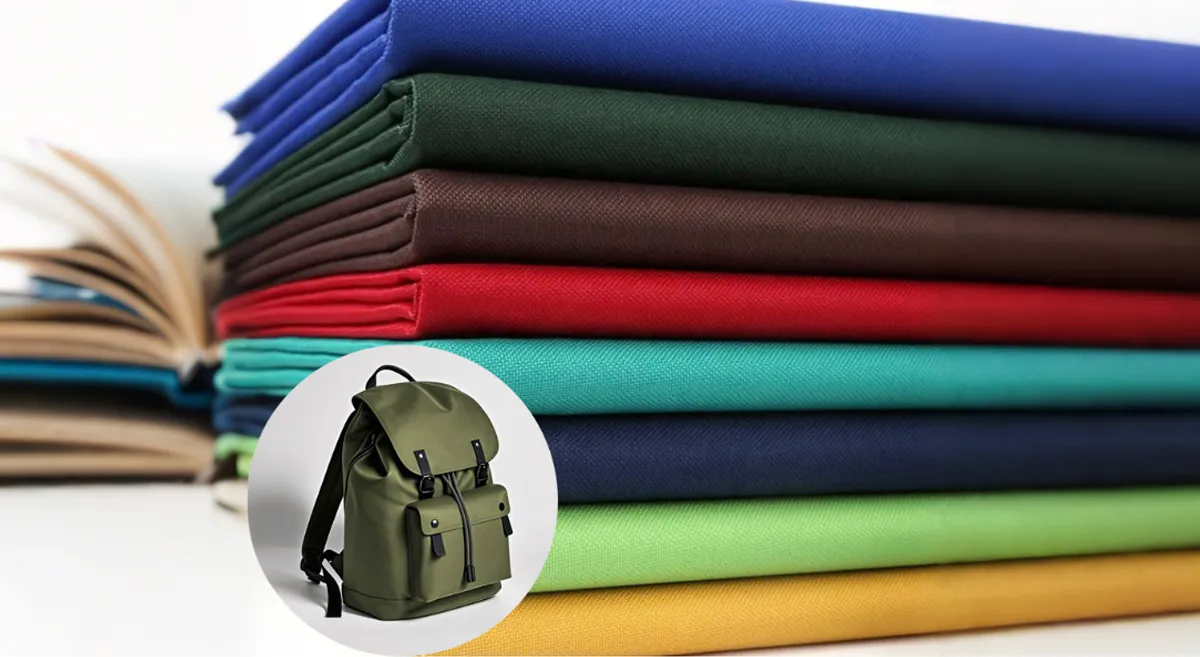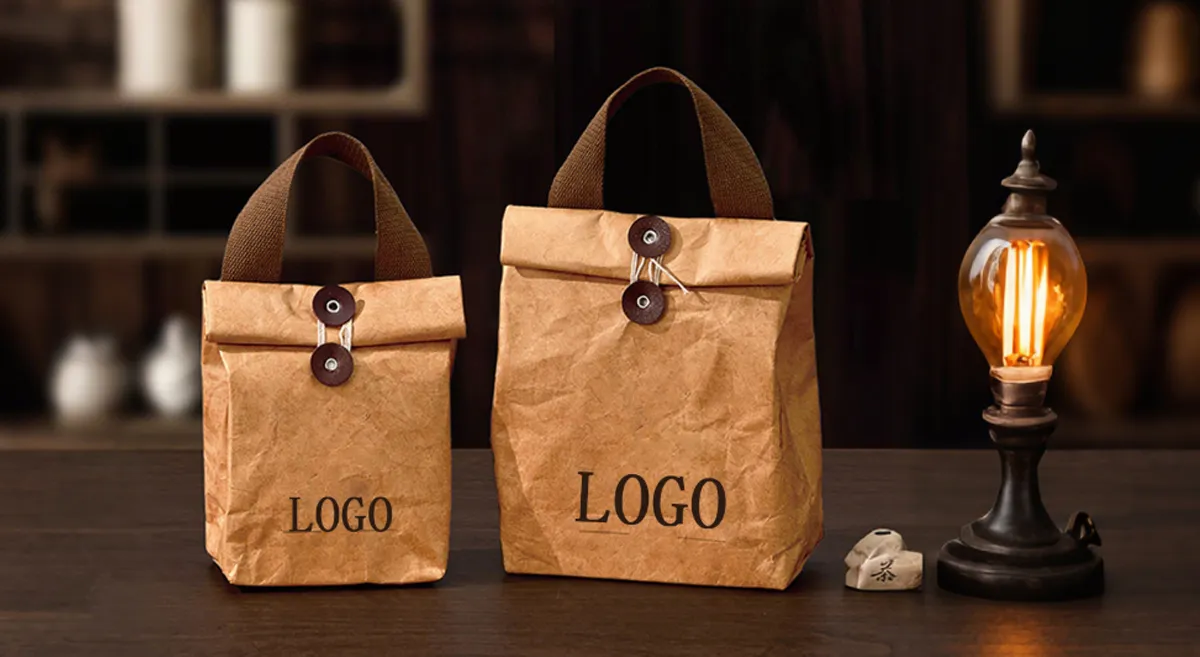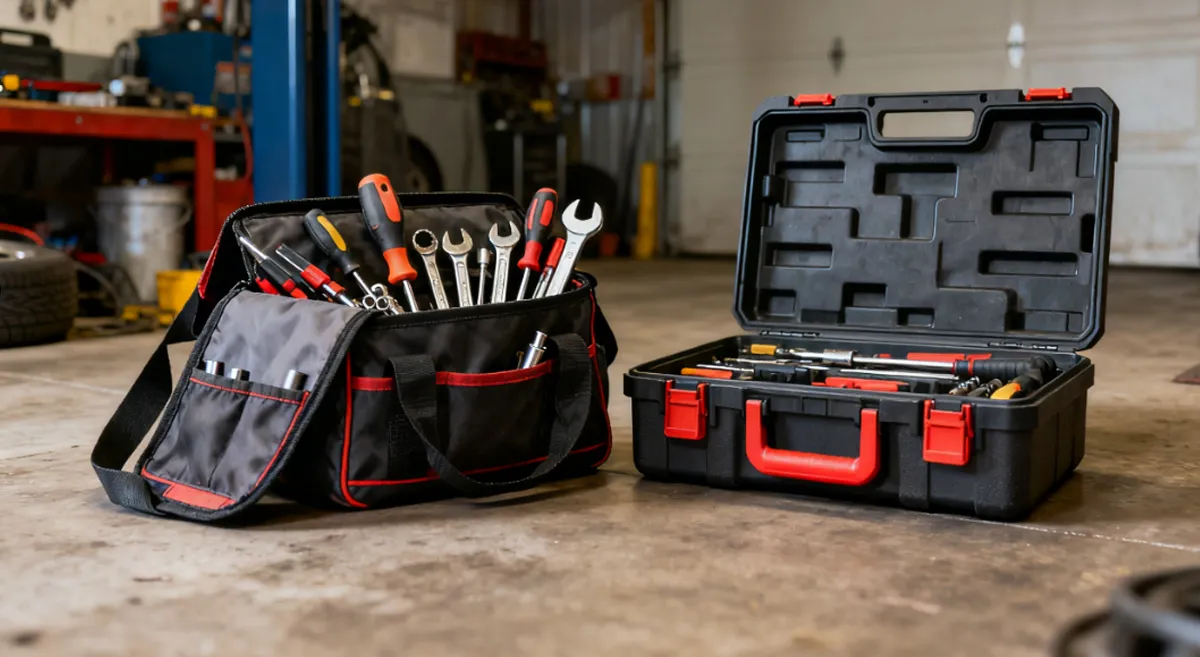
Choosing between tool bags and boxes really depends on your needs. If you want fast access to your tools for quick repairs around the house, a tool bag with lots of pockets and zip closures makes life easier. Maybe you’re a pro with a huge tool collection. A sturdy box keeps everything safe and organized. Think about how you work, what tools you use, and which features matter most. The right tool storage can save you time and hassle every day.
Key Takeaways
- Tool bags let you grab tools fast and carry them easily. They are good for people who move a lot for work.
- Tool boxes keep tools safe and neat. They work well for big tool sets in one place.
- Think about how you work. Pick tool bags if you want to move fast and be flexible. Pick tool boxes if you need strong and safe storage.
- Choose tool bags with lots of pockets. This helps you find tools quickly when fixing things.
- Rolling tool bags and boxes help you move heavy tools. You can carry them without hurting your back.
- Specialty tool bags are made for certain jobs. They have special parts to keep tools neat and easy to reach.
- Tool bags and boxes made from weather-resistant materials keep tools dry and clean. This helps your tools last longer.
- Clean and check your tool storage often. This keeps it working well and makes it last longer.
Tool Bags and Boxes: Key Differences
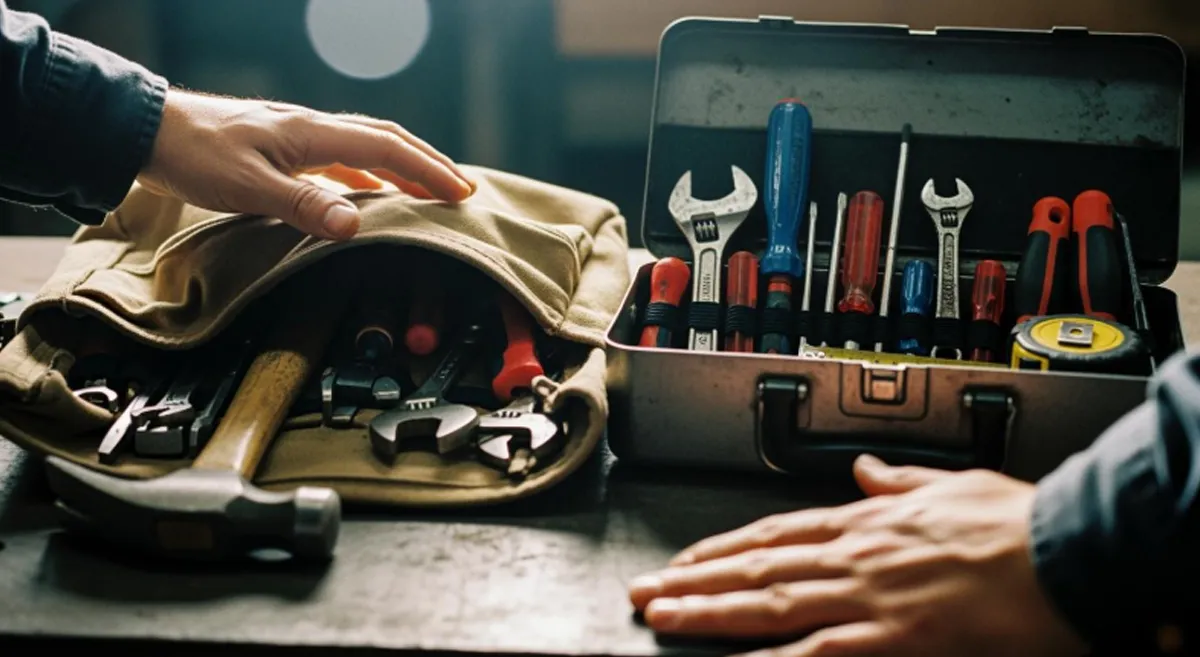
Flexibility and Efficiency
Tool bags and boxes are different in how flexible and efficient they are. Tool bags are great for people who move a lot. You can pick up your bag and go to your next job. Tool boxes are heavier and usually stay in one place. If you need to carry tools from room to room or across town, tool bags help a lot.
Here’s a quick look at how they compare:
| Feature | Tool Bags | Tool Boxes |
|---|---|---|
| Portability | Highly portable, easy to carry | Less portable, often heavier |
| Access Speed | Quick access to tools | Slower access due to design |
| Durability | Generally less durable | More durable, built to last |
| Common Usage | Preferred in modern film sets | Less common, traditional option |
You can fold tool bags when you are not using them. They have handles, shoulder straps, or backpack styles. This gives you more ways to carry your tools. Tool boxes are strong and steady, but they can be hard to move if they are full.
Tip: If you work in new places every day, a tool bag is flexible. If you work in one spot, a tool box could be better.
Organization and Access
It is important to keep your tools organized so you can find them fast. Tool bags and boxes organize tools in different ways. Tool bags have many pockets and dividers. You can sort your tools by size or type. This helps you grab what you need quickly.
Tool boxes have fixed spaces inside. When you open the lid, you see all your tools. Sometimes tools get mixed up, and you have to search for what you need.
Here’s a table to show how organization features compare:
| Feature | Tool Bags | Tool Boxes |
|---|---|---|
| Material | Nylon, polyester, or canvas | Metal or plastic |
| Storage Options | Various pockets, compartments, or dividers | Fixed compartments |
| Flexibility | Flexible and adaptable, can expand or contract | Rigid structure |
| Carrying Options | Handles, shoulder straps, or backpack straps | Usually handles only |
| Protection | Padded or reinforced walls for tool protection | Hard shell for tool protection |
| Accessibility | Easy-access openings, zippers, or Velcro closures | Lid opening only |
Tool bags let you reach your tools fast. Each pocket helps you find tools quickly. Tool boxes can slow you down because you may have to dig for tools. If you want to stay organized and save time, tool bags are a good choice.
Suitability for Different Users
Picking between tool bags and boxes depends on how you work and what tools you use. If you move around a lot, like an electrician or technician, tool bags are a good fit. You can carry small or medium tool sets and switch jobs easily. Tool bags are best for people who need to move fast and need easy access.
Tool boxes are better for people with lots of tools who work in one place. If you want to store your tools for a long time and keep them safe, tool boxes are stronger. They keep your tools safe and organized if you do not move them much.
Here’s a table that shows the main differences:
| Specification | Tool Organizer Bag | Tool Box |
|---|---|---|
| Size (Dimensions) | Large, often bulky | Varies, typically more compact |
| Material | Heavy-duty nylon, canvas, polyester | Metal, plastic, composite |
| Capacity | High – holds dozens of tools | Moderate to high |
| Weight | Can get heavy when fully loaded | Heavier due to materials |
| Mobility | Less mobile – carried by hand/strap | Less portable, often stationary |
| Ergonomics | May strain back if carried long | Designed for stability/support |
| Accessibility | Requires stopping to access tools | Tools stored away, need opening |
| Price Range | $10-$50+ | $20-$100+ |
| Best Use Case | Big jobs, organized storage | Long-term storage, protection |
If you want to organize your tools, both tool bags and boxes can help. Tool bags give you more ways to carry and organize. Tool boxes protect your tools better. Think about how you work, how many tools you have, and how often you move them. The right choice will help you stay neat and work faster.
Types of Tool Bags
Soft Tool Bags
Features
Soft tool bags are a favorite for many people who need to carry tools every day. You get a flexible design that makes packing and unpacking easy. Most soft tool bags use materials like nylon, polyester, or leather. Each material has its own strengths and weaknesses.
| Material | Pros | Cons |
|---|---|---|
| Leather | Tough, water-resistant, looks great | Heavy, needs care, costs more |
| Nylon | Strong, light, resists water, easy to clean | Can fade in sunlight, less stylish |
| Polyester | Cheap, keeps color, bends easily | Not as strong, can melt in heat |
Soft tool bags often have lots of pockets, sturdy handles, and padded bottoms. You can find duffel tool bags with big main compartments and smaller pockets for organizing your tools. Some even come with waterproof features, so your tools stay dry if you work outside.
Best Uses
You might choose a soft tool bag if you want something light and easy to carry. These bags work well for home repairs, DIY projects, and quick jobs. If you need to grab your tools and go, soft tool bags make it simple. They fit well in your car or truck and don’t take up much space. You can use them for gardening, fixing bikes, or small electrical work.
Tip: If you want a bag that bends and fits into tight spots, soft tool bags are a smart pick.
Tool Backpacks
Portability
Tool backpacks give you a hands-free way to carry your tools. You just sling the backpack over your shoulders and move easily from one place to another. This style works great if you need to climb ladders or walk long distances. Tool backpacks often have double shoulder straps that spread the weight, so you don’t feel tired as quickly.
Ergonomics
Carrying tools in a backpack helps your back and shoulders. You don’t have to hold a heavy bag in one hand. The straps balance the load, making it easier to walk and work. Tool backpacks usually have many compartments, so you can organize your tools and find what you need fast.
| Benefit | Description |
|---|---|
| Reduced strain | Less pressure on your back and shoulders |
| Increased productivity | Easy access to tools helps you work faster |
| Accommodates more tools | Bigger backpacks let you carry more tools |
If you work in a big building or need to move between jobs, a tool backpack can save you time and energy.
Rolling Tool Bags
Capacity
Rolling tool bags are perfect when you have lots of tools to move. These bags have wheels, so you don’t have to lift heavy loads. Some rolling tool bags can hold up to 250 pounds. You can pack power tools, wrenches, and other heavy items without worrying about hurting your back.
- Rolling tool bags carry more tools than most other types.
- Some models can handle up to 200 pounds, making them great for big jobs.
- You can organize your tools in different sections, so everything stays neat.
Mobility
You just pull a rolling tool bag behind you. The wheels make it easy to move across rough ground or long hallways. If you work on a job site or need to bring many tools to different places, rolling tool bags help you get the job done without extra effort.
Note: Rolling tool bags are a smart choice if you want to avoid lifting and need to move heavy tools often.
Specialty Tool Bags
Electrician Tool Bags
You need a bag that keeps your tools safe and easy to reach. Electrician tool bags do just that. These bags have special features that help you work faster and stay organized. You will find flexible slots in the main pouch. These slots hold your tools in place, so you can grab what you need without searching. Most electrician tool bags have about 15 tool slots and one tool loop. This setup gives you space for all your electrician tools.
The size of these bags makes them easy to carry. Many measure around 11 inches tall and 9 inches wide. You can take them anywhere without feeling weighed down. Everything inside stays visible. You see your tools right away. You do not waste time digging through the bag. Some bags have covered compartments for delicate items. These keep your small parts safe from damage. You also get a parts tray for hardware you use often.
Here’s what you might find in a good electrician tool bag:
- Flexible slots for organizing your tools
- 15 tool slots and a tool loop for versatility
- Compact size for easy transport
- Visible layout so you can grab tools quickly
- Covered compartments for delicate items
- Parts tray for hardware
Tip: If you want to keep your electrician tools neat and ready, choose a bag with lots of slots and covered pockets.
Trade-Specific Features
Specialty tool bags are not just for electricians. You can find bags made for plumbers, carpenters, and HVAC technicians. Each trade needs different tools, so the bags have unique features. Plumber bags often have waterproof bottoms. This keeps your tools dry when you work near water. Carpenter bags might have hammer loops and tape measure clips. HVAC bags usually have extra pockets for meters and gauges.
Let’s look at some trade-specific features in a table:
| Trade | Unique Features | Best For |
|---|---|---|
| Electrician | Flexible slots, covered compartments | Small hand tools, testers |
| Plumber | Waterproof bottom, wide opening | Wrenches, pipe cutters |
| Carpenter | Hammer loop, tape measure clip | Hammers, measuring tools |
| HVAC | Extra pockets for meters, gauges | Diagnostic tools, fast access |
You should pick a bag that matches your trade. The right features help you organize your tools and work faster. Specialty tool bags make your job easier and keep your tools safe.
Types of Tool Boxes
Metal Tool Boxes
Durability
Metal tool boxes last a long time. They are made from steel or aluminum. These boxes are strong and can handle rough use. If you drop one, your tools stay safe inside. Steel tool boxes do not rust or dent easily. You can use them for many years. Aluminum boxes are lighter but still strong. They work well outside because they resist rain and moisture.
Here’s a simple table showing how materials compare:
| Tool Box Type | Material Options | Key Characteristics |
|---|---|---|
| Steel | Steel | Heavy-duty, rust-resistant, ideal for storing heavy equipment, durable. |
| Aluminum | Aluminum | Lightweight, corrosion-resistant, weather-resistant, suitable for outdoor use. |
| Stainless Steel | Stainless Steel | Corrosion-resistant, sturdy, easy to clean, good for home and commercial use. |
Metal tool boxes are good for tough jobs or outdoor work.
Security
It is important to keep your tools safe. Metal tool boxes have strong locks. You can use padlocks or built-in locks. Thieves find it hard to break into metal boxes. You can mark your tools or check your inventory to keep track.
Here are some ways to keep tools safe:
- Write down every tool and its serial number.
- Check your tools often to see if any are missing.
- Use GPS tracking to know where your tools are.
You can add alarms or motion lights for more safety. These features help if you work in busy places or leave your box at a jobsite.
Plastic Tool Boxes
Lightweight
Plastic tool boxes are easy to carry. You can lift them without hurting your back. They are made from polypropylene or polyethylene. These boxes are good for small jobs or quick repairs. If you need to move tools often, plastic boxes make it easy.
| Advantage/Disadvantage | Description |
|---|---|
| Lightweight | Plastic toolboxes are easy to carry, making them suitable for transport and on-the-go projects. |
| Weight limitations | They have restrictions on how much weight they can safely hold, which can limit usability for heavy tools. |
Plastic tool boxes are best for light work or home use.
Affordability
Plastic tool boxes do not cost much. You can buy more than one for different tools. This helps you organize your things. Plastic boxes do not rust or stain, so cleaning is easy. They may not last as long as metal boxes if you use them for heavy work.
| Advantage/Disadvantage | Description |
|---|---|
| Cost-effective | They are generally more affordable than metal or fabric options, making them accessible for various users. |
| Durability concerns | Plastic toolboxes may not be as durable as metal ones, especially under heavy use. |
Plastic tool boxes help you save money and keep tools neat.
Molded Tool Cases
Protection
Molded tool cases protect your tools very well. They have hard shells that absorb bumps and drops. These cases keep delicate tools safe from damage. If you use electronics or special instruments, molded cases help you avoid repairs. They keep out dust and moisture, so your tools stay clean and dry.
| Feature | Molded Tool Cases | Other Storage Options |
|---|---|---|
| Shock and Vibration Protection | Engineered to absorb impacts, reducing damage risk | Often lack specialized protection |
| Environmental Sealing | Protects against dust, moisture, and corrosive elements | May not provide adequate sealing |
| Custom Organization | Foam inserts for precise tool placement | General storage without customization |
Molded tool cases are best for expensive or delicate tools.
Organization
Molded tool cases help you organize your tools. Foam inserts hold each tool in its own spot. You can see all your tools at once. You do not have to dig for the right tool. These cases are great for technicians and electricians. You can stack them or use modular boxes for more space.
Tip: Molded tool cases keep your tools neat and safe. You can set up the inside to fit your needs.
You have many ways to store your tools. Metal tool boxes are strong and secure. Plastic tool boxes are light and cheap. Molded tool cases give you protection and help you organize. Choose the best box for your tools and how you work.
Rolling Tool Boxes
Large Capacity
Do you have a big collection of tools? Rolling tool boxes might be just what you need. These tool storage solutions offer plenty of space for everything you use on the job. Most rolling tool boxes come with several drawers and compartments. You can sort your tools by type, size, or how often you use them. This makes it easy to find the right tool fast.
Imagine opening a tool chest with seven drawers. You see your wrenches in one spot, screwdrivers in another, and power tools in their own section. You do not have to dig through piles or waste time searching. Rolling tool boxes help you keep your tools neat and organized. If you work with lots of tools, you will appreciate how much easier your day becomes.
Here is a quick look at what you get with rolling tool boxes:
| Feature | Benefit |
|---|---|
| Multiple drawers | Sort tools by type or size |
| Large compartments | Store bulky power tools |
| Lockable sections | Keep your tools safe |
| Sturdy design | Handles heavy loads |
Tip: If you want to keep your tools organized and easy to reach, rolling tool boxes are a smart choice.
Jobsite Mobility
You do not want to carry heavy tool cases from place to place. Rolling tool boxes solve this problem. They have strong wheels and handles, so you can move your tools across the jobsite with little effort. You just grab the handle and roll your tool storage wherever you need it.
Rolling tool boxes work well on rough ground, concrete, or even up ramps. You do not have to worry about lifting heavy loads. This saves your back and helps you work faster. If you need to move tools between rooms or buildings, rolling tool boxes make the job simple.
Here are some reasons you might choose rolling tool boxes for jobsite mobility:
- You can move all your tools at once.
- You do not need help to transport heavy tool storage.
- You keep your tools safe while moving.
- You save time by rolling instead of carrying.
Note: Rolling tool boxes are perfect for busy jobsites. You stay organized and keep your tools close by, no matter where you work.
Rolling tool boxes give you the best of both worlds. You get large capacity for all your tools and easy mobility for any jobsite. If you want tool storage that keeps up with your busy workday, rolling tool boxes are worth considering.
Choosing the Right Tool Bags and Boxes
Work Style Considerations
You need the right tools for your job, but how you work matters just as much. If you move from place to place, you want storage that keeps up with you. Tool bags work well for people who travel between jobs or need quick access. Adjustable padded shoulder straps make carrying easy. You can grab your right bag and head out fast. Tool boxes suit those who stay in one spot and need more protection for their tools.
Here’s a table to help you compare:
| Feature | Tool Bags | Tool Boxes |
|---|---|---|
| Organization | Multiple pouches for vertical storage | Latching compartments, harder to organize |
| Portability | Adjustable padded shoulder straps for easy carry | Must be carried by hand, can be heavy |
| Versatility | Zip-closed, wide-mouth design for easy access | Limited to fixed compartments |
| Waterproof | Made with waterproof materials | Generally not waterproof |
| Protection of Small Items | Padded spaces for small items | Less protection for small items |
Professionals like plumbers and electricians often pick tool bags for their durability and portability. Mechanics might prefer tool boxes because they hold more tools. If you’re a DIYer, you can use either, but tool bags give you more flexibility if you add new tools later.
Tip: Think about your daily routine. If you’re always on the move, a tool bag could be your best friend. If you work in one place, a tool box might be the right choice.
Tool Collection Size
The number of tools you own makes a big difference. If you have a small set, a compact right bag keeps everything neat. You can organize your tools in pockets and find what you need quickly. If your collection grows, you might need more storage. Tool boxes offer larger compartments and can handle heavy loads.
- Small tool sets fit well in tool bags.
- Large tool collections need tool boxes for better storage.
- If you plan to buy more tools, choose storage that can grow with you.
You want to avoid clutter. The right bag or box helps you keep your tools sorted and easy to reach.
Job Environment
Where you work affects your choice. Outdoor jobs need storage that stands up to weather and rough use. Tool bags made with waterproof materials protect your tools from rain and splashes. Lightweight designs make carrying easier. Tool boxes offer heat insulation and keep your right tools safe in cold or hot conditions.
Here’s a table showing what matters in different environments:
| Characteristic | Description |
|---|---|
| Durability | High strength and wear resistance, ideal for outdoor environments. |
| Waterproof | Protects tools from rain and splashes, essential for outdoor work. |
| Lightweight | Low density makes it easy to carry, reducing burden for outdoor workers. |
| Heat insulation | Protects tools from extreme temperatures, ensuring functionality in cold conditions. |
You might work at a construction site, in the field, or even outdoors for camping or fishing. Tool bags keep your tools dry and easy to carry. Tool boxes protect your tools from impacts and temperature changes.
Note: Always match your storage to your job environment. The right tools stay safe, and you work faster.
Frequency of Use
How often do you reach for your tool bag or tool box? This question matters more than you might think. If you use your tools every day, you want storage that stands up to regular wear and tear. You need something that keeps your tool collection organized and ready for action. If you only grab your tool set once in a while, you can focus on simplicity and easy storage.
Let’s break it down. Daily use means you want quick access. You don’t want to waste time searching for the right tool. A tool bag with lots of pockets helps you stay organized. You can toss your tools in after work and know they’ll be ready tomorrow. If you work on different jobs, a bag with a sturdy zipper and reinforced handles makes life easier. You can carry your tools from place to place without worrying about damage.
If you use your tools less often, maybe for weekend projects or occasional repairs, a tool box might be the better choice. You can store your tool collection safely in one spot. You don’t have to worry about losing tools or having them scattered around. Tool boxes protect your tools from dust and moisture. You can tuck your tool box away in the garage or closet until you need it.
Here’s a simple table to help you decide:
| Frequency of Use | Best Storage Option | Why It Works |
|---|---|---|
| Daily | Tool Bag | Quick access, easy to carry |
| Weekly | Tool Box | Organized, protects from damage |
| Monthly | Tool Box | Safe storage, less wear and tear |
Tip: If you use your tools every day, invest in a tool bag with strong stitching and padded straps. If you only use your tool set now and then, a sturdy tool box will keep everything safe.
You should also think about how your workflow changes. If you start using more tools, you might need to upgrade your storage. A tool bag works well for fast-paced jobs. A tool box is great for keeping your tool collection neat when you don’t need it all the time.
Ask yourself: Do you need to grab your tools quickly? Do you want to keep your tool set safe between uses? Your answer will help you pick the right storage. The right choice keeps your tools in good shape and makes your work easier.
Organization and Customization in Tool Bags
Multiple Pockets
It is important to keep your tools neat and easy to find. Tool bags with many pockets help you do this. You can put each tool in its own spot by size or type. Many workers like bags with lots of pockets because they can grab tools quickly. Some tool bags have as many as 54 pockets, so you always have room for your tools.
Here’s a table showing popular pocket features:
| Feature | Description |
|---|---|
| Exterior Pockets | 3 exterior pockets for better organization |
| Interior Tool Wall | 29-pocket interior tool wall for extra organization |
| Bright Interior | Bright orange interior for easy visibility and access in low light |
| PALS-style Loops | Loops inside and outside for quick access to your favorite tools |
| Open Bottom Sleeves | Sleeves that keep small items from getting lost |
These pockets help you keep your tools sorted. You do not have to dig around for the right tool. You just pick what you need and start working.
Check out this chart comparing pocket types in tool bags:
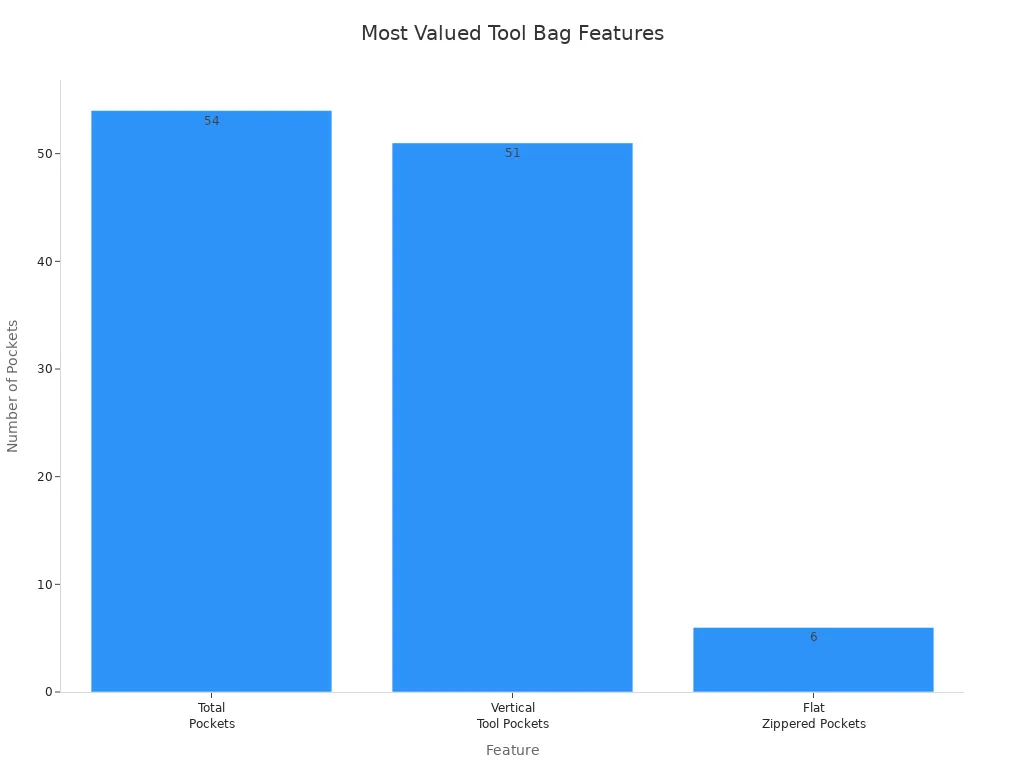
Tip: Pick a bag with lots of pockets if you want your tools easy to find.
Customizable Layouts
Sometimes you need a tool bag that fits the way you work. Customizable layouts let you set up your bag just how you want. You can group tools by job or use colors to mark each section. This makes your work faster and easier.
Here’s a table showing how customizable layouts help:
| Feature | Benefit |
|---|---|
| Logical groupings | Reduces time spent searching for tools |
| Color-coded or labeled compartments | Minimizes interruptions during work |
| Modular expansion options | Supports tailored organization for tasks |
You can change the inside of your bag to fit your job. Electricians might want special slots for pliers and testers. Plumbers can add space for wrenches and cutters. Custom layouts help you see and grab every tool fast.
Note: Custom tool bags help you work quicker and keep your tools in order.
OEM and ODM Options
Do you want a tool bag that matches your team or company? OEM and ODM choices let you make special tool bags for your group. You can pick the colors, design, and features you like best.
Here’s a table comparing OEM and ODM benefits:
| Benefit | OEM (Original Equipment Manufacturer) | ODM (Original Design Manufacturer) |
|---|---|---|
| Design Ownership | Complete control over designs, ensuring brand uniqueness. | Limited customization; core designs owned by the manufacturer. |
| Customization Levels | High degree of customization tailored to brand specifications. | Limited customization options, mainly logos and colors. |
| Cost Efficiency | Higher initial costs due to custom designs and materials. | More cost-efficient for bulk orders and quicker production. |
| Time to Market | Longer development time for unique designs. | Faster production with existing designs, ideal for quick market response. |
OEM is good if you want to control how your tool bag looks and works. ODM is better if you want something fast and want to save money. Both choices help you get tool bags that fit your business and help your team look special.
Tip: Custom tool bags show off your brand and keep your tools neat. You get the storage you need and the style you like.
Practical Scenarios for Tool Bags and Boxes
Quick Access Needs
You want to grab your tools fast when you work on repairs or small jobs. Tool bags make this easy. You can sling a bag over your shoulder and head straight to the task. Many tool bags have lots of pouches and pockets. You see your tools right away. You do not waste time searching. Adjustable straps help you carry your bag comfortably, even if you move from room to room or job site to job site.
Here are some reasons tool bags work well for quick access:
- You reach your tools without opening heavy lids.
- You organize your tools in separate pockets.
- You carry your bag easily with a handle or strap.
- You expand your bag if you need more space.
Tool boxes do not offer the same speed. You often need to open the box and dig through compartments. If you want to save time and keep your tools handy, a tool bag fits your needs.
Tip: Choose a tool bag with bright interiors or labeled pockets. You find your tools even in low light.
Large Tool Storage
Sometimes you own a big collection of tools. You need strong tool storage that keeps everything safe. Tool boxes shine in this area. They have sturdy shells and lockable lids. You store large tools like drills, saws, or hammers. Tool boxes protect your tools from bumps and drops. You stack them in your garage or workshop without worry.
Let’s compare tool bags and tool boxes for large tool storage:
| Feature | Tool Bags | Tool Boxes |
|---|---|---|
| Capacity | Good for small to medium tools | Best for large and heavy tools |
| Protection | Padded walls, less rigid | Hard shell, very sturdy |
| Organization | Many pockets, flexible layout | Fixed compartments, less flexible |
| Mobility | Easy to carry, less for heavy | Harder to move, but safer |
If you need to store heavy or bulky tools, a tool box is your best choice. You keep your tools organized and protected for long-term storage.
Specialized Trades
You work in a trade like electrician, plumber, or HVAC technician. Your job needs special tools and fast access. Tool bags designed for trades give you what you need. These bags have tough materials that stand up to daily use. You find pockets for meters, testers, and small accessories. You keep your tools sorted and ready for action.
Here’s why tool bags help in specialized trades:
- You organize your tools by job type.
- You keep accessories and meters in easy-to-reach spots.
- You carry your bag from one job to the next without hassle.
- You use durable bags that last through tough work.
Electrician tool bags have slots for pliers, screwdrivers, and testers. Plumber bags offer waterproof bottoms and wide openings. You pick a bag that matches your trade and keeps your tools safe.
Note: If you work in a specialized trade, look for tool bags with reinforced stitching and trade-specific pockets. You stay efficient and keep your tools in top shape.
Home and DIY Use
You might wonder which option works best for your home projects or DIY tasks. You want something that keeps your tools organized and easy to reach. Tool bags and tool boxes both offer good solutions, but your choice depends on how you use your tools and where you work.
If you fix things around the house, you probably need quick access to your favorite tool. A tool bag makes it simple. You grab your bag, head to the garage, or walk to the backyard. You find your tools in separate pockets, so you do not waste time searching. Tool bags often have soft sides, so you can squeeze them into tight spaces like under the sink or behind the couch.
Do you have a small collection of tools for basic repairs? A compact tool box might suit you. You keep your hammer, screwdriver, and tape measure in one spot. You close the lid and store your tool box on a shelf or in a closet. Tool boxes protect your tools from dust and moisture. You do not worry about losing small parts.
Let’s look at some common home and DIY scenarios:
- You hang pictures or fix loose screws. You want your tool close by.
- You build furniture or work on crafts. You need to organize your tools for each step.
- You repair bikes or garden equipment. You carry your tool storage outside.
Here’s a table to help you decide:
| Scenario | Best Option | Why It Works |
|---|---|---|
| Quick repairs | Tool bag | Fast access, easy to carry |
| Small tool collection | Tool box | Keeps tools safe, simple storage |
| Outdoor projects | Tool bag | Portable, fits in tight spaces |
| Crafting or hobbies | Tool box | Organized, protects delicate tools |
Tip: If you want to keep your tools handy for any project, choose a tool bag with lots of pockets. If you prefer to store your tool collection in one place, a sturdy tool box works well.
You do not need a huge tool storage system for home use. You want something that matches your style and fits your space. Tool bags give you flexibility and speed. Tool boxes offer protection and neatness. Pick the one that helps you finish your DIY projects with less hassle.
Common Concerns with Tool Bags and Boxes
Durability
When you pick tool storage, you want it to last. Durability matters because you use your tools every day. If your bag or box breaks, you lose time and money. Many people talk about problems with handles that snap or cannot hold the weight of their tools. Weak stitching at the bottom of bags often leads to tears. Wheels on rolling bags sometimes crack or the bolts fall out. Some tool boxes do not stack well, so the lids do not close right. You might also see bottom seals fail, which lets water in and makes your tools damp.
Here are some common durability issues users report:
- Handles that break or bend when you carry heavy tools.
- Stitching at the base that comes apart after a few months.
- Wheels that crack or lose bolts, making it hard to move your storage.
- Tool boxes that do not stack well, causing lid problems.
- Bottom seals that leak, leaving your tools wet.
If you want your tool storage to last, look for high-quality construction. Strong handles, thick stitching, and sturdy wheels help your bag or box survive tough jobs. You should check the bottom seal before you buy. A good seal keeps your tools dry and safe. Electrician tool bags often use reinforced stitching and padded handles for extra durability.
Weather Resistance
You might work outside or in places where water and dust are everywhere. Weather resistance helps keep your tools safe. Some tool bags use waterproof materials, so rain or spills do not ruin your tools. Tool boxes with tight lids and rubber seals block out moisture. If you leave your storage in a truck or on a jobsite, you want it to stand up to the weather.
Look for tool storage with water-resistant zippers and sealed seams. These features keep your tools dry. If you work as an electrician, you know how important it is to protect your tools from water. Wet tools can rust or stop working. A weather-resistant bag or box saves you from buying new tools all the time.
Tip: Always check if your tool storage has waterproof features before you buy. You will thank yourself on rainy days.
Security
You want your tools to stay safe. Security is a big concern for anyone who owns expensive tools. Tool boxes often come with locks or places for padlocks. This keeps your tools away from thieves. Some tool bags have zippered pockets or hidden compartments for small items. If you work on busy jobsites, you need storage that protects your tools.
Here are some ways to keep your tools secure:
- Use a tool box with a built-in lock.
- Pick a bag with zippered pockets for small tools.
- Store your tool storage in a safe place when you finish work.
- Mark your tools with your name or a code.
Security features help you relax. You know your tools are safe, even if you leave them for a while. If you use your tools every day, invest in storage that keeps them protected.
Maintenance
Taking care of your tool bag or tool box helps you get the most out of your investment. You want your gear to last, right? Good maintenance keeps your tools safe and makes your work smoother. Let’s talk about some simple steps you can follow.
First, regular cleaning makes a big difference. You should empty your bag or box every so often. Wipe down the surfaces with a damp cloth. If you use a soft tool bag, let it air dry before you pack your tools back in. This stops mold and keeps your bag smelling fresh. For tool boxes, a quick wipe removes dust and grime. You don’t want dirt building up around your tools.
Next, inspect for wear and tear. Handles, seams, and zippers take a lot of stress. Check them often. If you spot a loose thread or a sticky zipper, fix it before it gets worse. Handles sometimes crack or bend, especially if you carry heavy tools. You can replace them or reinforce them with tape. Catching problems early saves you money and keeps your tools safe.
Organizing and decluttering helps too. You probably toss new tools into your bag or box without thinking. Over time, things get messy. Take a few minutes to group similar tools together. Remove anything you don’t use. This makes it easier to find what you need and keeps your storage neat.
Proper storage matters. You should keep your tool bag or box in a dry, clean place. Moisture causes rust and weakens fabric. Sunlight fades colors and can make plastic brittle. Find a spot in your garage or workshop that stays cool and dry. If you work outside, bring your bag or box indoors when you finish for the day.
Different materials need special care. If you have a leather tool bag, use a leather cleaner and conditioner. Nylon and canvas bags clean up with mild soap and water. Cordura fabric resists stains, but you should still wipe it down. Metal tool boxes need a little oil on the hinges to stop rust. Plastic boxes just need a quick wash.
Here’s a handy table to help you remember:
| Maintenance Tip | What to Do |
|---|---|
| Clean regularly | Wipe surfaces, air dry, remove dirt |
| Inspect for damage | Check seams, zippers, handles, fix issues early |
| Organize tools | Group similar items, remove clutter |
| Store properly | Keep in dry, cool place, avoid sunlight |
| Care for materials | Use right cleaner for leather, nylon, canvas |
Tip: Set a reminder to check your tool bag or box once a month. A little effort keeps your gear in top shape and saves you headaches later.
You don’t need fancy products or lots of time. Just a few simple habits help your tool storage last longer and work better for you.
Conclusion
You want the best tool storage for your work. Tool bags fit you if you move around and need quick access to your tools. Tool boxes work well when you have a big tool collection and need strong protection. Ask yourself about your work style and the type of tool you use. Make sure you pick what keeps you organized. Need custom tool bags? Contact us for OEM and ODM options!
FAQ
What’s the main difference between a tool bag and a tool box?
You carry a tool bag over your shoulder or by hand. You roll or lift a tool box. Tool bags give you quick access. Tool boxes protect your tools better.
Which is better for heavy tools?
You should pick a sturdy tool box for heavy tools. Metal boxes hold more weight and keep your tools safe. Tool bags work best for lighter items.
Can I use a tool bag for outdoor jobs?
Yes! Many tool bags use waterproof materials. You keep your tools dry in rain or mud. Look for sealed seams and strong zippers.
How do I organize small tools in a tool bag?
You use pockets, loops, and dividers. Group similar tools together. Bright interiors help you see everything. You find your tools faster.
Are tool boxes secure enough for expensive tools?
Most tool boxes have locks or spots for padlocks. You keep your tools safe from theft. Metal boxes offer the best security.
What’s the easiest tool storage for quick repairs at home?
You grab a tool bag with lots of pockets. You carry it anywhere and find your tools fast. Tool bags work great for quick fixes.
How do I clean and maintain my tool bag?
You empty your bag and wipe it with a damp cloth. Let it air dry. Check for loose threads or broken zippers. Fix problems early.
Can I customize my tool bag for my trade?
Yes! You choose bags with special pockets or layouts. Some companies offer custom colors, logos, and features. You get a bag that fits your job.



